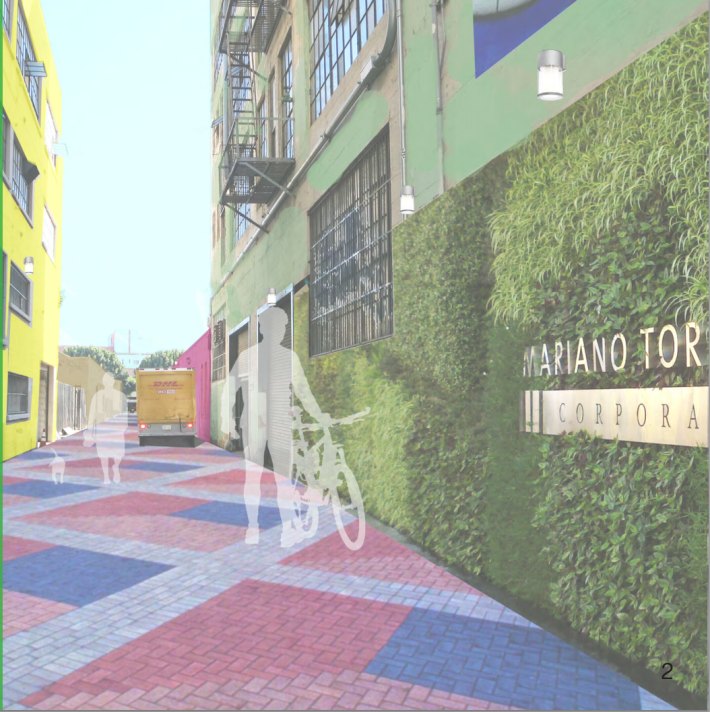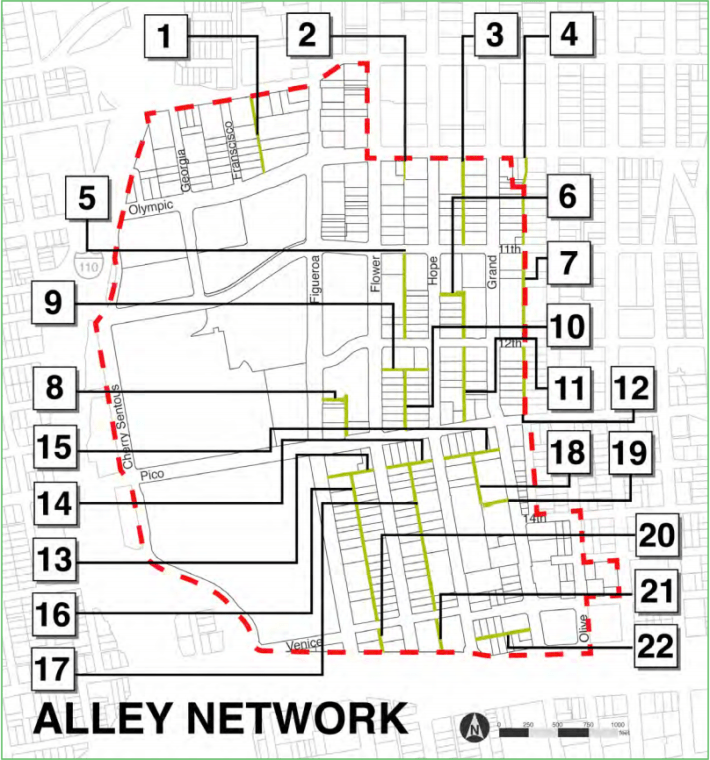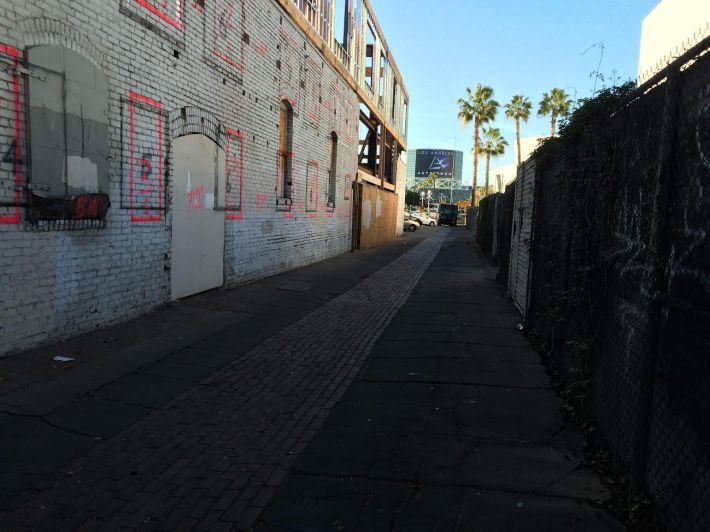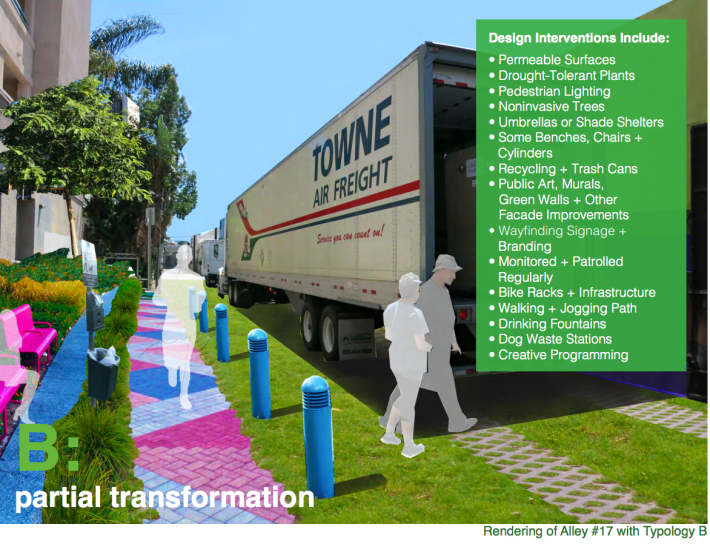A Changing South Park Plans for “Livable Alleys”
10:34 AM PST on January 6, 2015

Through cinematic distortion, alleys are seen as hubs where criminals engage in drug dealing, whacking, and even murder.
In reality, most city alleys are wasted, often unkempt spaces cluttered with toilets and mattresses due to illegal dumping.
Despite this reality, alley spaces offer great, unrealized potential, says the South Park Business Improvement District (BID).
As part of the BID’s focus on "bettering the physical and social environment for residents, property owners, and businesses of the area," Executive Director Jessica Lall and Director of Planning and Communications Amanda Irvine have undertaken the task of transforming South Park's alleys into livable green spaces as part of a larger plan to revitalize and rebrand South Park.
Bringing livable green alleys to South Park will help foster community, allow for greater recreation opportunities, reduce crime, and will offer expanded retail opportunities, Lall and Irvine claim.
Green alleys, as defined in the Green Alleys in South Park Visioning Report [PDF], are alley spaces that have been transformed and rebuilt to include "materials and features that reduce environmental impacts" and/or spaces that have undergone transformation via the addition of "plantings and landscaping." Environmental impacts of the green livable initiative include rainwater capture and filtration and relief from the heat island effect.

Acknowledging the differences in alley space and the diversity of community needs, the report recommends three typologies to be implemented in South Park’s alleys: (A) complete transformation, (B) partial transformation, and (C) baseline transformation.
Under the complete transformation outlined by Typology A, both residential and commercial spaces may potentially achieve greater public accessibility. When fixtures such as pedestrian lighting, shade shelters, benches, drinking fountains, and even murals are implemented, alleys are able to "provide open space amenities" to South Park's residents and workers, who already use these spaces as walkways. Furthermore, commercial businesses gain accessibility to otherwise unused space via the conversion of alleys into dining, vending, and event space.
Parking restrictions set forth by the partial transformation of Typology B ultimately grant all forms of transportation equal use of the space, especially for the ability of "non-motorists to circulate." Although vehicles are able to use alleys for loading purposes, they will no longer be able to use the space for parking, thus creating a pedestrian-friendly environment.
Although the baseline transformations of Typology C allow for greater vehicle use of alleys in comparison to Typology B, the general public is still granted full accessibility to the space.
Deciding which typology is most appropriate for given alleys ultimately depends on how the space is currently used, says Irvine, who joined the BID shortly after January 2013 with an M. A. in Urban Planning.
In their visioning report, the BID has designated over 20 potential alleys in the South Park neighborhood for renovations under the green livable initiative.
Working with the Los Angeles Sustainability Collaborative, the Urban Land Institute of Los Angeles, and the offices of L.A. City Councilmember Jose Huizar, the BID’s goal is to begin implementing green alleys in 2015 through the use of Quimby funds, where applicable. Raising funds remains a key component of every stage of the project.
The BID’s visioning report estimates the total cost of this project will not exceed $19 million, a number based on the cost of renovating Hollywood’s East Cahuenga “EaCa” alley. The EaCa alley underwent a complete transformation, with construction costs totaling approximately $785,600. Transforming the EaCa alley was a reasonably expensive project, notes the report. Based on this cost, South Park’s green livable initiative may cost up to $19 million if all 21 neighborhood alleys undergo complete Typology A renovations (an unlikely occurrence).
Although a plan for implementation has been outlined, Lall says the BID must partner with the Los Angeles Bureau of Street Services and the Department of Transportation in order for livable green alleys to become a reality.
Renovating alley space becomes relatively easier after “looking at existing vehicles and obligations developers already have to fulfill and seeing if there’s any way this project can satisfy them,” says Lall. Developers have to meet several city requirements before starting new buildings including public space and public art baselines. By investing in Green Alleys, developers can meet some of those requirements.
Determined to bring public art to South Park, the BID has already brought South African muralist Faith 47 to the corner of 12th and Flower in collaboration with the Do Art Foundation Faith 47’s “The Preciousness of the Hunt”

Lall and Irvine highlight the importance of community support in the work they do for the South Park BID, making sure to meet with the local community on an annual basis. Community leader Victor Moller, who manages senior housing for 1010 Development, would love to see green livable alleys become a reality but doubts it is possible without 24/7 surveillance.
“I designated a portion of [Pembroke Lane, which doglegs from Olympic to Flower] for dogs. I had a park bench I left out there, too. I found that people were mostly using it for drinking and smoking weed. I actually took the bench away because it was a disturbance. Our family housing on Hope Street, which shares our alley, has a day care. There are children there and I don’t think it’s a good idea to have people taking drugs around them,” says Moller.
Moller also shared instances when he caught people peeing and even having sex in the alley he oversees.
“It’d be really nice to have green spaces, but unless it had 24-hour security, I don’t see it working,” says Moller. The BID isn’t planning on hiring new security, but believes that increasing the public use of a space can make the space safer.
“[T]he physical improvements that we are planning on doing to green and activate the alleys will inherently make them safer places, with more people using them and more eyes on the street,” writes Irvine: “The alleys exist in the community already, and are not seen as a safe or friendly place to be. However, as we work to enhance them through the program we're building, they will become brighter, safer, cleaner, and more sustainable places. Yes, there will still be security and maintenance to do there, but in making the alleys more like the public open space they can be, we'll be creating less of a need for surveillance than we already have.”
Other beautification projects the BID has undertaken include sidewalk repairs, bringing murals and other forms of public art to South Park, partnering with City Trees to bring greenery into the community, and implementing a parklet on 11th and Hope with the help of People St, a program within the city’s Transportation Department (LADOT) aimed at creating accessible, livable spaces in Los Angeles.
“The idea is to turn South Park into the park at large,” says Irvine, expressing her desire to transform South Park into the neighborhood originally planned by the city in its unrealized “silver book plan,” which would have created a large central park for the community.
Stay in touch
Sign up for our free newsletter
More from Streetsblog Los Angeles
Metro Board Funds Free Student Transit Pass Program through July 2025
Metro student free passes funded another year - plus other updates from today's Metro board meeting
Eyes on the Street: New Lincoln Park Avenue Bike Lanes
The recently installed 1.25-mile long bikeway spans Lincoln Park Avenue, Flora Avenue, and Sierra Street - it's arguably the first new bike facility of the Measure HLA era
Brightline West Breaks Ground on Vegas to SoCal High-Speed Rail
Brightline West will be a 218-mile 186-mile-per-hour rail line from Vegas to Rancho Cucamonga - about 40 miles east of downtown L.A. - expected to open in 2028






